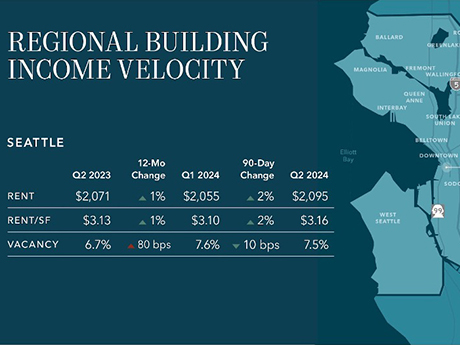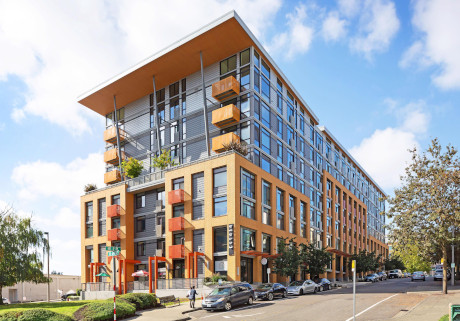— By Dylan Simon, executive vice president, Kidder Mathews — This summer marked a major milestone in Seattle’s apartment market, demonstrating signs of vibrancy with increases in rental rates, growing liquidity and clarity in pricing in capital transactions. The city is gaining momentum and continues to bounce back from recent market fluctuations and the harsh impacts of the pandemic. Urbanization is here to stay — corporate employers are voting against Zoom as an effective tool — as we trend back toward human nature, which requires community and proximity. With limited new construction breaking ground, the stage is set for sustained rental rate growth, which will invariably result in a surge in sales prices. Transaction Activity on the Rise Transaction activity is steadily on the rise in Seattle’s multifamily market, proving conviction from the investment community. This uptick offers greater clarity on property values as the market adjusts from peak interest rates back in fall 2023. For owners and potential sellers, this shift suggests pricing hit a bottom in the past nine months and the only direction in pricing from here is upward. In our recently launched third-quarter Seattle market report, we’ve uncovered key sales insights that underscore this resurgence. During the …
Market Reports
— By Leah Masson, senior director, Cushman & Wakefield — The real estate landscape in the Puget Sound region is shaped by a dynamic contrast between the Eastside and Downtown Seattle. The Eastside continues to thrive, particularly with its robust tech activity. Major developments, such as the Eight, Skanska’s 540,000-square-foot project, is nearing full occupancy, underscoring the area’s strong demand. OpenAI is actively seeking space on the Eastside, with expectations of more artificial intelligence groups to follow. It’s worth noting that the Eastside is not plagued by the safety issues that have been a concern for Downtown Seattle. The anticipated 2025 opening of the light rail is set to drive even more growth in the area. Downtown Seattle is also experiencing an uptick in leasing activity, with active tenants expanding in terms of both square footage and lease term lengths. Since 2021, professional services groups, such as law and engineering firms, have been the primary drivers of leasing, but there is now a welcome return of tech companies to the Seattle market. New AI-focused tenants are beginning to emerge, moving out of coworking spaces and seeking permanent office locations in the city. However, Downtown Seattle continues to face significant challenges, …
— By R.J. Vara, first vice president of investments, Marcus & Millichap’s The Vara Group — The Seattle industrial market is undergoing a transitional phase marked by rising vacancies, fluctuating demand and evolving investment dynamics. There was a robust surge from 2020 to 2022, which saw nearly 19 million square feet of industrial space absorbed and more than $8.4 billion in transaction volume. However, the market experienced a reversal in 2023, with roughly 2 million square feet of previously absorbed space becoming available. This shift, driven by decreased container traffic at local ports, rising interest rates and elevated inflation, has continued into 2024, with speculative construction projects contributing to elevated vacancy rates. As of mid-year, Seattle’s industrial vacancy rate has increased by about 2 percent year over year, reaching 7.7 percent. This has surpassed the national average of 6.6 percent. The rise in vacancies is primarily attributed to the completion of new distribution facilities, with spaces of more than 100,000 square feet now available in double digits. Delivery numbers are expected to fall to their lowest level since 2017, but investors are beginning to explore opportunities in the southern regions. Regarding investment activity, Seattle’s industrial sales volume has notably increased …
— By Jacob Pavlik, research manager, Colliers — A 10-mile drive east of Seattle, Bellevue is the top destination for urban retail activity in the Puget Sound. High incomes, healthy daytime employment and the most active office leasing market in the Pacific Northwest means not much more is needed to make a retail space thrive. That is, except reasonable fit-out costs for new space. The Bellevue CBD has seen significant new construction for office buildings (with lots of ground-floor retail opportunities), delivering 3.3 million square feet over the past year alone. Unfortunately, sky-high construction pricing and office market financing challenges have made it difficult to get retail leases done in new buildings. Second-generation spaces in the submarket are the reasonable but diminishing alternative. Second-generation spaces are filling up faster than they become available. The demand is partially from tenants whose buildings were torn down for redevelopment. Given the cost of fitting out a space in a brand-new building elsewhere in the Bellevue CBD, second-generation space is the most lucrative alternative. First-generation space, which delivers as a cold shell without HVAC, plumbing or dry wall, can cost upward of $400 per square foot to build out. Landlords tend to offer $100 …
— By Candice Chevaillier, CCIM, Principal, Lee & Associates | Pacific Northwest Multifamily Team — Absorption still lags supply in the Seattle MSA contributing to higher vacancy and flat rents. In Q1 2024 3,000 units were delivered, yet only 2,800 were absorbed. Vacancy is stabilizing at 6.9 percent this quarter and then is expected to trend down starting in Q3, finally allowing meaningful growth in rents. Construction costs remain high and options for financing limited, curtailing new development. This is creating demand for existing value-add acquisitions. 2024 and 2023 sale volume in the Seattle MSA is still a trickle of what it was in 2022 and 2021, shifting Cap Rates slowly upwards. This trend is expected to be short-lived. As interest rates finally begin to fall, and rents begin to rise, investors who catch this inflection point will prevail from best pricing and benefit while more conservative capital sits on the sidelines.
— By Alex Muir, Senior Vice President, Lee & Associates | Seattle — As we near the halfway mark of 2024, capital markets activity in Seattle remains slow. The year has largely consisted of price discovery and waiting for interest rates to drop. With that said, the sales volume for office assets has nearly surpassed the 2023 total. Four transactions over $30 million have occurred year-to-date, all of which are larger than any deal last year. These sales are emblematic of the type of deals that are driving investment activity, with three being owner-user acquisitions — Alaska Airlines, Costco, Seattle Housing Authority — and the fourth involving a loan assumption. Distressed sales are occurring more frequently as well, with several buildings in downtown Seattle trading below $150/SF. While it has yet to materially impact vacancy, there are signs of life in the leasing market. Pokémon recently signed a lease for 16 floors in The Eight, an under-construction tower in the Bellevue CBD. This is the largest lease in the market in three years. Other tenants, such as ByteDance and Snowflake, have signed leases larger than 100,000 SF, as a new wave of tech companies grow in the market. With the …
— By Vanessa Herzog, SIOR, CCIM, Principal, Lee & Associates | Seattle — Industrial markets in the Pacific NW are adjusting to new parameters but remaining steady. Vacancy rates are hovering around 7% in the 6-county region along the I-5 corridor (Arlington to Vancouver, WA). Leasing activity slowed in the first quarter but started picking up as we progress through the second quarter. New construction is active with permitted projects, but the regional project pipeline is diminishing, not due to demand, but due to high land price expectation, stabilized rental rates and continued high costs of new construction. We think this trend will continue well into 2025 leaving Developers and Land Sellers frustrated. Regionally, large land parcels are difficult to find or assemble, leaving Developers looking at infill assemblages, land use changes or full site redevelopment. IOS specialized properties are slowing in demand from Tenants. Finally, we are seeing the small owner user facilities for sale or lease, and the demand from this user group level off. Here are some statistics: Total Inventory at 398M SF, Current Vacancy rate 7% (27.8M SF), Market Asking Rates $1.12/SF/Mo., Sublease Space 20% of total vacancy (5.6 M/SF): New Construction underway 9.9M SF. Demand …
Inflated Interest Rates Impact Values, but Tech and Growth Drive Resilience in Metro Seattle
by Jeff Shaw
— By Steven Chattin, Managing Director, Berkadia — Nationwide, inflated interest rates are significantly impacting property values. In the Seattle metro, cap rates are increasing while values decline and bridge debt rates hover at 8 percent or higher — non-starters for many multifamily investors. The common play is to secure favorable short-term financing for if and when rates come back down. Due to these factors, family offices, high-net-worth individuals and private capital groups are the most active players in today’s market. Lenders are also feeling the impact of the economic environment, with the current depth being extremely shallow for competitive options. As transactions slow, some players are scaling back or stepping out of certain arenas entirely. Umpqua Bank recently shuttered its multifamily lending operation on the West Coast. According to second-quarter data provided by CoStar, multifamily sales volume has decreased by 50 percent year over year. Agency debt is most favored right now with fixed rates preferred over floating rate debt. Where available, loan assumptions are generally the most attractive option and have bridged many deals across the finish line. Challenges aside, many developers are staying busy as evidenced by the nearly 12,000 additional units projected within the Seattle-Tacoma metro …
— By Lisa Stewart, Senior Managing Director, JLL; and Nick Menghini, Puget Sound Research Manager, JLL — Real estate market participants are maintaining cautious optimism for improved conditions across the Puget Sound as signs of vitality are emerging despite persistently challenging economic forces. Viewed through the lens of prior real estate cycles, it’s clear the Seattle area has a greater critical mass of highly skilled talent and a broader, more resilient economic base than previous slowdowns. Among the promising indicators are the Puget Sound’s rebound of population in-migration, from net outflows during the pandemic to more than 53,000 new residents moving here in the first half of the year. Seattle now lays claim to being the fastest growing of the top 50 U.S. cities, according to Census data. Several leading employers are also growing again. This includes Boeing, which has more hiring underway than in years’ past. Rising star Blue Origin has had about half as many open positions as Boeing over the past 12 months. The life sciences sector is further expanding as Big Pharma firms like Pfizer, Moderna and Novartis join homegrown startups with significant Puget Sound presences. Overall, companies encouraging a return-to-office (RTO) have brought more daytime foot traffic to employment …
— Jennifer Seversen, Vice President, CBRE — Suburban retail is emerging as the main driver of retail growth in Seattle. In the height of the pandemic, many consumers stayed close to home, rediscovered their neighborhoods and began shopping primarily in their communities. These habits have continued and, as a result, retailers on once-heavily trafficked commute paths have experienced declining sales revenue. Retailers are taking notes, particularly those in city office districts that rely heavily on daytime foot traffic. The white-hot activity in suburban retail has led to vacancy rates under 2 percent, healthy rent growth and record-breaking absorption within new developments. Rents in suburban markets like Totem Lake, Bothell and Woodinville are outpacing downtown Seattle by 50 percent, something that would not have been conceivable three years ago. Well-located mixed-use retail projects and neighborhood centers have led the way in pushing rent growth, while grocery-anchored developments have been attractive assets to investors. Restaurants have proven to be a major driver of retail activity, with Seattle having a 7 percent increase in diners year over year through the second quarter, the fifth highest increase in the U.S., according to OpenTable. An example of the rise in suburban retail demand is Harvest, …
Newer Posts








